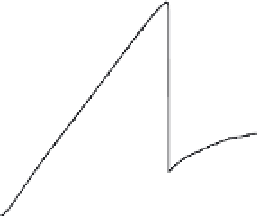Environmental Engineering Reference
In-Depth Information
0.5
-3.0
NB-7 (19.2-19.5m): Intact
NB-4 (23.6-23.9m): Compacted at SP
NB-4 (23.6-23.8m) (natural state)
soaking at constant vert. stress
initial water content: 7.3 to 9.4%
0.4
0.3
-2.0
0.2
0.1
-1.0
0.0
1
10
100 1000 10000 00000 000000
Entrance pore size, x(nm)
Figure 8. Pore-size distribution curve of compacted
(standard effort, nB-4) and intact (nB-7) samples.
0.0
0
100
200
Figure 8 shows the pore-size distribution curve in
terms of the log differential intruded void ratio as
a function of the entrance pore size, which aids in
the visual detection of the dominant pore modes. as
observed, the sample displayed a double-porosity
network with two dominant modes, one formed by
large macro-pores at 1-2 µm and a small micro-
pores range at 20-40 nm.
Vertical stress (kPa)
Figure 9. evolution of vertical strain (swelling) dur-
ing soaking at different vertical stresses. intact core
sample nB-4.
400
NB-4 (23.6-23.8m) (natural state)
σ
'
v
= 52kPa
σ
'
v
= 104kPa
σ
'
v
= 208kPa
2.3
Strength
Tests were carried out in a direct shear cell with a box
60 mm in diameter and 25 mm high. The following
steps were performed: a) loading at constant (initial)
water content; b) soaking at approximately 1 min
(this saturation stage was maintained for 24 hours);
and c) shearing during 1 day at constant horizontal
displacement rate of approximately 5 µm/min up to
a maximum of 8 to 9 mm. The shearing rate was low
to ensure drained conditions. The vertical stresses
applied were 52, 104 and 208 kPa. as observed in
Figure 8, the natural sample displayed some swell-
ing on soaking at low stresses.
The evolution of shear stresses at different ver-
tical effective stresses during direct shear tests is
presented in Figure 9. Figure 10 plots the shear
strength envelopes for different conditions (peak,
just after peak and ultimate conditions), along
with the shear strength parameters.
Figure 11 indicates that the tuff has a marked
brittle behaviour. Peak shear strength param-
eters are high (
φ′
= 44°;
c′
= 176 kPa). Post-peak
behaviour is characterized by (
φ′
= 37°;
c′
= 32
kPa), which is judged suitable for foundation con-
ditions. The residual shear strength, measured on
remoulded samples by means of a ring shear appa-
ratus provides
φ′
res
= 29°. This value is high and it
is not explained by the high plasticity measured
in samples. however, the correlations plasticity-
residual friction established for sedimentary/regular
300
200
100
0
0
2 4 6 8
Horizontal displacement (mm)
10
Figure 10. evolution of shear stress (direct shear test
on intact core sample nB-4).
clay soils are of doubtful validity here. The fact is
that the direct determination of the residual fric-
tion provided a high friction angle in the specimen
tested. The amorphous mineral content may explain
this result.
2.4
Hydraulic related properties
a water permeability test was run on intact nB-7
sample using controlled-gradient conditions in an


























































































